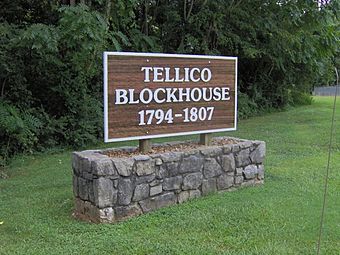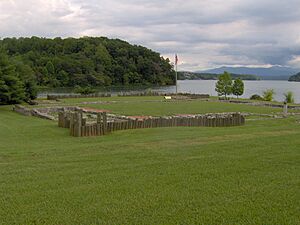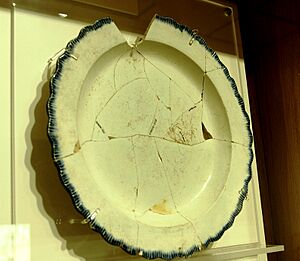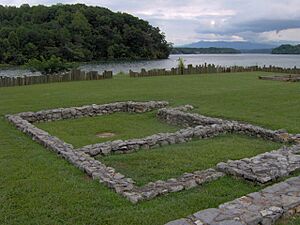Tellico Blockhouse facts for kids
Quick facts for kids |
|
|
Tellico Blockhouse Site
|
|

Entrance sign to the Tellico Blockhouse State Historic Area
|
|
| Location | Vonore, Tennessee, USA |
|---|---|
| NRHP reference No. | 75001771 |
| Added to NRHP | 1975-08-11 |
The Tellico Blockhouse was an important early American outpost. It was located along the Little Tennessee River in what is now Vonore, Monroe County, Tennessee. This blockhouse was finished in 1794. It served as a US military base until 1807. Its main goal was to keep peace between the nearby Overhill Cherokee towns and the new European-American settlers. This was especially important after the Cherokee–American wars.
The Tellico Blockhouse was also a place where many treaties were signed. These agreements were between the United States and the Cherokee people. Through these treaties, the Cherokee gave up large parts of their land in what is now Tennessee and Georgia. The US government offered money and other benefits for these land deals. During this time, the blockhouse was the main meeting spot for US officials and the Cherokee Nation.
Today, the site is called the Tellico Blockhouse State Historic Area. It was added to the National Register of Historic Places in 1975. Staff from the nearby Fort Loudoun State Historic Area help manage it.
Contents
Where Was the Tellico Blockhouse Located?
The Tellico Blockhouse site is found where Nine Mile Creek meets the Little Tennessee River. This area is now part of Tellico Lake. It sits between the towns of Maryville and Vonore. U.S. Route 411 runs close by.
Fort Loudoun was just across the river to the west. But it was already in ruins when the blockhouse was built. The Tellico Blockhouse originally stood on a high cliff. From there, it looked over the Little Tennessee valley.
Important Cherokee towns like Chota and Great Tellico were a day's travel to the south. The river town of Morganton was also very close. Knoxville was about thirty miles away by river. People crossed the Little Tennessee River at Niles Ferry. This was because no bridges were built until much later.
In 1979, the Tellico Dam was finished on the Little Tennessee River. This created Tellico Lake. The lake's edge now comes very close to the blockhouse site. Historically, the Tellico Blockhouse was also the start of the Old Federal Road. This road connected Knoxville to Cherokee settlements in Georgia.
A Brief History of the Blockhouse

In the late 1700s, more and more European-American settlers moved into East Tennessee. This led to conflicts with the Cherokee people. The Cherokee had lived on this land for hundreds of years. There were often fights. The Cherokee would raid settlements, and settlers would attack Cherokee villages in return.
This violence became very bad in 1793. The Cherokee attacked a place called Henry's Station. Settlers then attacked the Cherokee village of Tallassee. Even when Cherokee chief Hanging Maw was trying to make peace with Governor William Blount, some settlers attacked his group. Several Cherokee leaders were killed.
Chief Hanging Maw convinced Governor Blount to build a fort near the Cherokee towns. This fort would help stop the violence. The chief even gave the land for it. The Tellico Blockhouse was finished in 1794. Federal troops from Knoxville were sent to guard it.
John McKee was the first Tellico Indian Agent. He was the official contact person between the United States government and the Cherokee Nation.
Building the Fort
The blockhouse was a simple fort. It was made from earth and timber. Wooden planks were brought upstream from Knoxville.
A historian named J. G. M. Ramsey described it in 1853. He said it was "a strong work, of considerable size." It had parts sticking out on each side with holes for guns. It was built to defend against enemies with small weapons.
The first blockhouse was about 120 by 100 feet. It was surrounded by a tall fence, called a palisade, about 16 feet high. The main gate was on the north side. The captain's living area and the guardhouse were just inside. The fort also had two barracks for soldiers, a well, and a parade ground. A watchtower stood in one corner.
The Tellico Factory
In 1795, the US Congress passed the Factory Act. This law aimed to improve relations with Native Americans. It set up official trading posts. It also taught Native Americans new farming and mechanical skills.
To do this, the Tellico Blockhouse was made much bigger. It almost doubled in size. A new section was added for civilians. This part was separated from the military area by a wall. It had places for travelers and visitors to stay. It also had a two-story building called the Tellico Factory.
The factory had a trading post. Here, European-American tools and goods were traded for Native American furs and raw materials. The factory also taught members of the new Cherokee Nation mechanical arts. They learned how to spin and weave cloth.
Important Events at the Blockhouse
In April 1797, a big secret plan was uncovered at the Tellico Blockhouse. It was called the "Blount Conspiracy." Senator William Blount tried to get Britain to attack and capture the Spanish port of New Orleans.
James Carey, a merchant, told James Byers about Blount's plan. Byers was a government trader at the Blockhouse. Byers then gave a letter from Blount to Colonel David Henley in Knoxville. Henley sent it to Secretary of State Timothy Pickering. Because of this letter, Blount was later removed from the Senate.
In December 1797, one of the first recorded Christmas celebrations in Tennessee happened here. The Little Tennessee River froze over. Silas Dinsmoor and the soldiers had a dinner party on the ice on Christmas night.
Ramsey described it from an old news article: "On the 25th, a Christmas dinner was given upon the ice... to a large company of gentlemen and ladies." He also wrote that "two quarters of a bear were barbecued" on the ice. The ice was strong enough to hold a fire big enough to roast an ox!
The Tellico Blockhouse was likely busiest around 1799. This was because it was on the Old Federal Road. That same year, Louis-Philippe, who later became king of France, visited the blockhouse. In 1800, several Cherokee leaders met there. They discussed whether to let missionaries come into Cherokee towns. The Cherokee hoped missionaries would help educate their children.
The Blockhouse Closes
In the early 1800s, the Cherokee slowly moved south. They went to the Hiwassee River and deeper into Georgia. They were trying to get away from the growing number of European-American settlers. As the Cherokee towns along the Little Tennessee River became less active, the Tellico Blockhouse became less important.
In 1801, Colonel Return J. Meigs became the new Cherokee agent. This meant the main agency moved to Fort Southwest Point. In 1805, the last Tellico treaty called for the soldiers to leave the blockhouse. They moved south to the Hiwassee River area.
In the 1970s, archaeologists from the University of Tennessee dug at the Tellico Blockhouse site. They found the fort's foundations and many old items. Because there were not enough records, they decided not to rebuild the blockhouse. Instead, they strengthened the foundations. This way, visitors can still see where the fort was laid out. Short posts show where the walls once stood. Signs at the site explain the fort's history.
The site is now a State Historic Area. It is listed on the National Register of Historic Places. Staff from the Fort Loudoun State Historic Area manage it. Some of the items found during the dig are shown at the Fort Loudoun museum. Others are at the Frank H. McClung Museum in Knoxville.
Important Treaties Signed at Tellico
Several important agreements, called treaties, were signed between the United States and the Cherokee Nation at the Tellico Blockhouse:
- A treaty signed on November 8, 1794, ended the Cherokee–American wars. Cherokee chiefs Hanging Maw (for the Upper Cherokee) and Colonel John Watt (for the Lower Cherokee, or "Chickamauga") met with Governor William Blount. Everyone agreed to respect the borders set in earlier treaties.
- The 'First Treaty of Tellico' was signed on October 2, 1798. It was meant to pay the Cherokee for land that illegal settlers had taken. In exchange for this land, the Cherokee received money and a promise that the Cherokee Nation would "exist forever."
- The 'Second Treaty of Tellico' was signed on October 24, 1804. This treaty brought the Wafford settlements in northern Georgia under US control. The Cherokee received money for giving up these lands.
- The 'Third Treaty of Tellico' was signed on October 25, 1805. The 'Fourth Treaty of Tellico' was signed two days later, on October 27. These treaties gave the US control over land between the Cumberland River and Duck River. This was most of the Cumberland Plateau. The US wanted to connect East Tennessee with Nashville.



